If you've started hearing the Realme name relatively recently, you're not alone, because the once-small tech company has been enjoying a meteoric rise over the last few years.
Realme originated in China but it’s an up-and-comer in the rest of the world, especially in India and Europe, where its low-cost smartphones are making waves in the budget and mid-range price brackets. The company isn’t averse to premium models though, and the GT line which debuted in 2021 includes some top-end handsets.
In fact, Realme has been one of the quickest-growing phone companies for the last few years, so they're definitely worth paying attention to.
Below we’ll run you through a brief history of the company as well as the types of products it puts out, and everything else you need to know about the brand.
A brief history of Realme
Realme was founded in 2010 as a sub-brand to another smartphone company - Oppo, but gained independence in 2018, when it started producing its own smartphones.
Since then the company has put out phones at an impressive rate, and it’s also expanded from selling phones in India and China to many other parts of the globe too.
Realme joins other smartphone brands Oppo, OnePlus and Vivo as belonging to a tech conglomerate called BBK Electronics. The exact relationship between BBK’s smartphone companies has never been specified, but we sometimes see tech and innovations shared between the companies, especially Oppo and OnePlus.
What phones does Realme make?
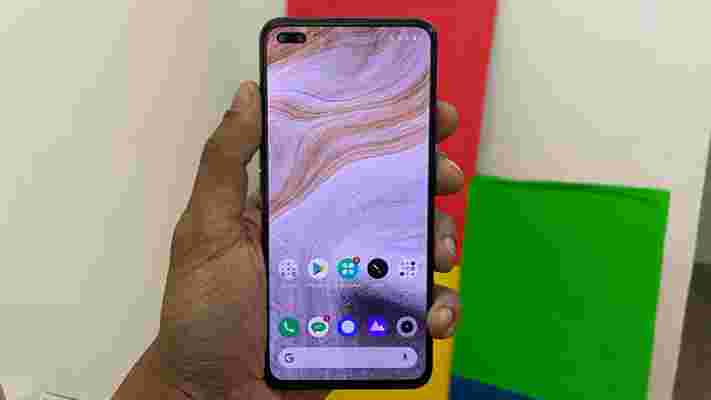
Realme has two main smartphone lines, though that could change soon, as we’ll get into. In some regions the company has many more lines of smartphones like the Narzo, Q, C and V-prefix devices, but they’re not globally available, so we won’t go into detail on them.
The first of the two main lines is Realme's numbered line, with handsets like the Realme 7 and Realme 7 Pro. These are affordable and low-mid-range devices that rival Motorola’s Moto G or Xiaomi’s Redmi line, with cheap and cheery phones designed for people who need dependable devices without top specs.
Then there's the Realme GT line, which was launched in 2021 as a replacement to the 'X' line. While X devices were mid-rangers, the GT line straddles middle-tier and high-end phones, with the GT 2 Pro the company's first premium flagship phone.
Realme GT phones generally offer top-end processors, fast charging and colorful designs, with less of an emphasis on camera capabilities.
Realme phone availability information
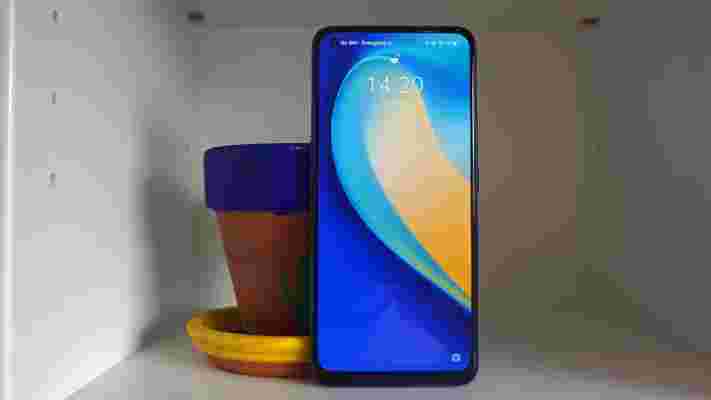
As Realme is fairly new, and has put out loads of smartphones since its debut, it’s hard to discern any particular patterns in its release schedule. Unlike many other phone brands, the company doesn’t seem to adhere to a yearly launch plan.
Regarding availability, Realme currently sells smartphones in most parts of the world, though the US is one exception. However, in an interview with TechRadar , Madhav Sheth, Realme’s CEO, suggested the brand could bring its devices to the US before too long as well. This could be a few years off though.
Other tech Realme sells
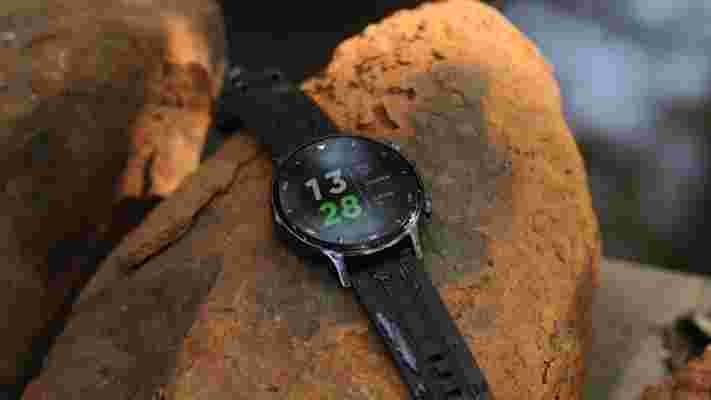
Like most tech companies, Realme has a product ecosystem of non-smartphone devices, though it’s rolling out its devices slowly. The company calls this its 1+4+N strategy where the ‘1’ is your smartphone which controls gadgets in 4 key areas including audio and wearables, which are helped by ‘N’ which denotes smart home and Internet of Things (IoT) devices.
The non-smartphone gadgets include wireless headphones like the Realme Buds Air , smartwatches like the Realme Watch and fitness trackers like the Realme Band. In some regions the brand also has smart home appliances and TVs.
The company has pledged to rapidly expand its portfolio through 2021 though so we could see routers, tablets and more coming, though we don’t have clarity on exactly what.
Halo TV show trailer debuts Cortana's new look – and fans aren't happy
The official Halo TV show trailer has finally arrived – and fans have had plenty to say about Cortana's new look in the live-action series.
Debuted during halftime of the AFC Championship game on Sunday (January 30), the trailer gave us our first detailed look at Halo's TV adaptation. And, for the most part, it looks pretty good, even if some creative liberties have been taken with its plot and style.
But fans really can't get over Cortana's aesthetic in the upcoming Paramount Plus TV show. Traditionally, Master Chief's AI companion has been blue or purple in the iconic gaming franchise . As you can see in the image below, though, Cortana's normal hue has been replaced by a more lifelike hologram, complete with white skin and black hair:

Unsurprisingly, Halo fans have taken to social media in their droves to criticize Cortana's new look, with many hitting out at Paramount and 343 Industries, Halo's current developer, for altering the AI's beloved appearance.
On Twitter, Spartanin229's "What did you do to Cortana!?" comment summed up many fans' complaints , while Ringframe posted a screenshot of Cortana alongside a very abrupt "what the ****" message.
Another user in MOGWILD called on fans to push for Cortana's design to be changed – a move that would be reminiscent of how Sonic the Hedgehog's aesthetic (another Paramount production, coincidentally enough) was altered after fan backlash to the speedster's initial live-action design:
Over on Reddit, detrydis said it was "weird" that Cortana's appearance had been completely changed, while Msan28 opined that they really didn't like "the humanized Cortana".
Dontloseyourway1610 agreed with MOGWILD's tweet, too, saying that the Halo fanbase should force Paramount and 343 to change Cortana's look, before Ill_Ratio_5682 said that Cortana looked "fake", and asked why she didn't retain her holographic look as seen in the games.
Reactions to Cortana's design weren't universally negative. Twitter user R0bSkii told disgruntled fans not to watch the series if they weren't happy with what they'd seen so far, while NemaCystx called out critical fans for being "entitled".
Finally, J_Drage_ believes fans should be grateful that Jen Taylor – Cortana's original voice actor – reprises her role as the AI companion. It's a comment that a few people agreed with on Reddit, too, including notyourancilla .
Such positive comments, however, are outnumbered by those who can't (or refuse) to take to Cortana's new aesthetic. And, while the Halo TV show isn't officially canon within the franchise's main timeline, it's understandable why fans are aggrieved at the AI's revised look.
Paramount's Halo live-action series has retained plenty of other signature Halo elements. Master Chief's armor, the incredibly detailed Elites, UNSC and Covenant weapons, and vehicles feel like they've been pulled directly from the first-person shooter series.
From a design perspective, then, it does seem like an odd decision not to keep Cortana's look from the games. It doesn't help Cortana doesn't look like Dr. Catherine Halsey, either. In the games, Halsey modeled Cortana's physical appearance on her own, so the fact that Cortana doesn't look like Natascha McElhone – who portrays Halsey in the TV show – doesn't help matters.
The Halo TV show will launch exclusively on Paramount Plus on March 24, so there's still time for Paramount and 343 to revise Cortana's TV look. You know, providing they want to do so.
Apple Watch 7 vs Samsung Galaxy Watch 4: which is the best smartwatch?
The Apple Watch 7 and the Samsung Galaxy Watch 4 are possibly the two most high- profile smartwatches on the market. They could also be the two best.
They’re also made by two companies who are simultaneously bitter rivals and frequent collaborators. Apple and Samsung have been riffing off one another for years, whether they care to admit it or not.
Basically, when it comes to smartwatch faceoffs, they don’t come any tastier than this one. We even gave both four out of five reviews in 2021, which tells you it’s a close-fought battle.
So which smartwatch is the better of the two, the Apple Watch 7 or the Samsung Galaxy Watch 4? Let’s take a closer look.
Apple Watch 7 vs Samsung Galaxy Watch 4: price and availability
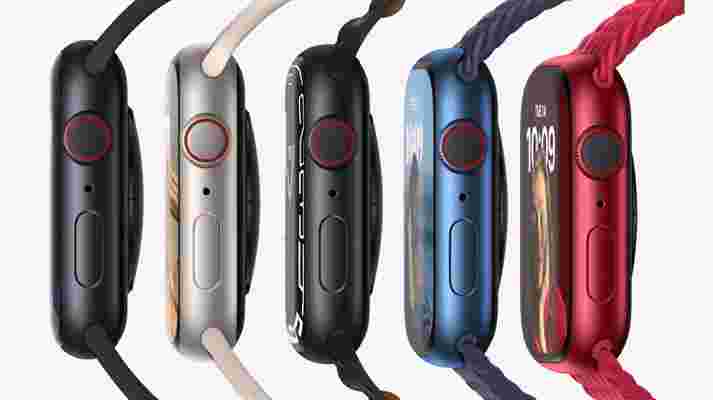
The Apple Watch 7 hit shops on October 15, 2021. Prices start from $399 / £369 / AU$599 for the non-cellular 41mm model, while $429 / £399 / AU$649 will secure you the non-cellular 45mm model.
For the cellular models, the 41mm model will cost you $499 / £469 / AU$749, and the 45mm model costs $529 / £499 / AU$799. You’ll need to factor in the price of a data plan on top of that.
For the Samsung Galaxy Watch 4, it’s available to buy now in the US and UK where it went on sale on August 26, 2021, and September 10 in Australia. There’s also a Samsung Galaxy Watch 4 Classic model that gives you a more premium design with a physical rotating bezel.
The smaller non-cellular 40mm version of the plain Galaxy Watch 4 costs $250 / £249 / AU$399, while the cellular version costs $300 / £289 / AU$499. The 44mm non-cellular model costs $280 / £269 (about AU$500), while the LTE unit costs $330 / £309 (about AU$580).
Finally, the range-topping Galaxy Watch 4 Classic starts from $349 / £349 / AU$549 for the 42mm Bluetooth model and $399 / £389 / AU$649 for the 42mm LTE model. Stepping up to the 46mm model comes in a Bluetooth version for $379 / £369 / AU$599, or an LTE variant at $429 / £409 / AU$699.
If you can pick up a distinct taste from that model soup, well done. All you really need to know is that the Apple Watch 7 is the more expensive of the two lines, and that the Galaxy Watch 4 gives you more options to suit your particular budget.
Apple Watch 7 vs Samsung Galaxy Watch 4: design & display
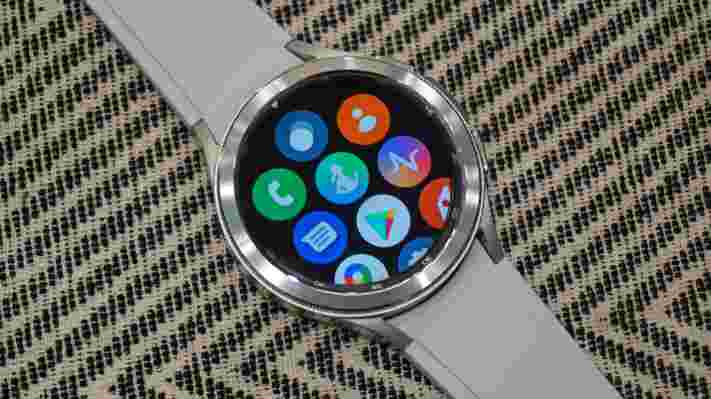
Apple and Samsung took fundamentally different approaches to smartwatch design. Apple’s watch is square, while Samsung’s watches are round.
Yes, Samsung has two different iterations of the Galaxy Watch 4. They’re very similar, which is why we’ll refer to them in the singular for much of this feature.
Essentially, the Galaxy Watch 4 is smaller, lighter and has a capacitive touch-sensing band, while the chunkier Galaxy Watch 4 Classic has a physical rotating bezel for navigation. The Apple Watch 7, of course, uses a much more discrete crown that’s used to similar effect.
In terms of sizing, the Apple Watch 7 comes in 41mm and 45mm guises, while the Samsung Galaxy Watch 4 comes in 40mm and 44mm. The Samsung Galaxy Watch 4 Classic is even larger at 42mm and 46mm.
Both Samsung and Apple wearables are dustproof and water-resistant to 50 meters.
When it comes to available colors, the Apple Watch 7 gives you Starlight, Midnight, Blue, Green, and Product Red.
With the Galaxy Watch 4, Samsung split the color options between the two sizes. The 40mm model comes in black, gold and silver, while the 44mm model comes in black, green and silver. All are relatively muted.
It’s tricky to compare the displays of these two devices given that one is square and one is circular, but we’ll try. The Apple Watch 7’s 1.9-inch screen is 20% larger than its predecessor, and is also larger than the Galaxy Watch 4’s 1.4-inch equivalent.
They’re similarly pixel-dense, though, at 326ppi for the Apple Watch and around 330ppi for the Galaxy Watch 4. Both are punchy AMOLEDs, and are two of the clearest smartwatch displays on the market.
Another difference is that the Apple Watch 7’s display curves off at the edges, while the Galaxy Watch 4’s is much flatter and more utilitarian.
Apple Watch 7 vs Samsung Galaxy Watch 4: fitness & features
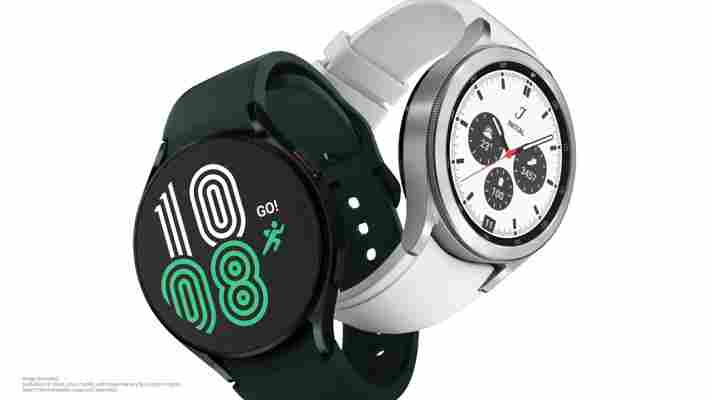
With its tougher body, the Apple Watch 7 is better equipped for fitness usage than previous models. Despite this, it’s still somewhat lacking in a few key areas.
It still lacks things like interval sessions and heart rate alerts, for example. What it does provide is a blood oxygen sensor, an electrical heart sensor, a third-generation optical heart sensor, GPS, and a barometric altimeter. Its GPS and heart rate monitoring accuracy is up there with some decent dedicated trackers.
The Apple Watch 7’s electrocardiogram (ECG) and blood oxygen (SPO2) monitoring facility isn’t medical-grade, however, and thus isn’t of particular value.
The Samsung Galaxy Watch 4 sports a new three-in–one BioActive Sensor that enables the watch to monitor heart rate, blood oxygen levels and body composition. The latter is done using a unique bioelectrical impedance sensor (BIA), and it lets you monitor things like skeletal muscle mass and body fat percentage.
It’s this body composition tracking feature that sets the Galaxy Watch 4 apart from the Apple Watch 4 on the health tracking front.
Meanwhile, the Apple Watch 7’s ace card here is Apple Fitness+. Apple’s trainer-based workouts have been expensively assembled, and give it a clear fitness edge over its rival if you need a little extra motivation to stick to a fitness routine.
We found the Galaxy Watch 4’s GPS tracking capabilities to be similarly on point to the Apple Watch 7’s.
It’s worth pointing out that the fitness facilities of both of these smartwatches only really work to their full potential when you also own a smartphone by the same manufacturer. We’re accustomed to Apple’s walled garden approach, but the Galaxy Watch 4 similarly cordons off its ECG and blood pressure monitoring facilities for Samsung smartphones.
Apple Watch 7 vs Samsung Galaxy Watch 4: OS, power and battery
Apple fitted the Apple Watch 7 with an S7 chip, which is an ostensibly new custom processor. However, it’s actually the S6 chip from the Apple Watch 6 with a slightly different design.
We’d love to gripe about this somewhat deceptive move more, but the truth is that the Apple Watch 7 is plenty smooth enough. You don’t get any of the jank that you frequently do in lesser smartwatches.
Of course, the Samsung Galaxy Watch 4 is not one of those lesser smartwatches. It too uses custom silicon in the form of the Samsung Exynos W920, and we found it to be one of the smoothest and most responsive wearables we’ve ever used.
One way in which the Apple Watch clearly wins is onboard storage. At 32GB, it has double the capacity of the Galaxy Watch 4, giving you much more headroom for apps and offline music.
Both of these watches have seriously strong software, at least compared to other smartwatches. Apple’s WatchOS 8 is probably the best smartwatch OS out there, but Samsung has supplied a strong rival. It ditched its own Tizen OS and returned to Google’s WearOS, albeit with its own distinctly Tizen-like UI.
Both are a joy to use, with finely honed interfaces and richly populated app stores. If you’re a fan of typing full messages from your watch, meanwhile then both watches will provide the facility with full keyboard functions.
When it comes to stamina, the Apple Watch 7 regularly got us through a full 24 hours on a single charge. The Samsung Galaxy Watch 4 went even better, with two to three full days between charges depending on the frequency and intensity of your fitness regime.
We should note that this relates to the 44mm model of the Watch 4, with its larger 361mAh battery. We haven’t yet tested the stamina of the 40mm model, so it may not fare quite as well. The Apple Watch 7 has a 309mAh cell, but direct capacity comparisons don’t mean all that much given that they use completely different operating systems.
Takeaway
The Apple Watch 7 packs a wide variety of impressive features, and provides a superb second screen for iPhone users. It’s not much of an upgrade over the Apple Watch 6 , but it’s the best smartwatch for iOS users nonetheless.
The Samsung Galaxy Watch 4 is a more impressive upgrade over its own predecessor, with a superior Wear OS-based operating system and excellent battery life.
Both watches provide solid fitness features and silky performance, as well as comfortable fits. The Apple Watch 4 has the more premium design, but you’ll have to pay a little extra for the privilege. Really, they’re very close when you stack up the pros and cons.
It sounds obvious, but what it really comes down to is this: if you have an iPhone, the Apple Watch 7 is the better smartwatch. If you have a Samsung phone, the Galaxy Watch 4 is better.
Both have compatibility issues with non-branded phones, though the Galaxy Watch 4 comes out stronger in terms of Android smartphone operability. For that reason it’s safe to call the Galaxy Watch 4 the better pick for most people, even if the Apple Watch 7 is arguably the better smartwatch with all things being equal.